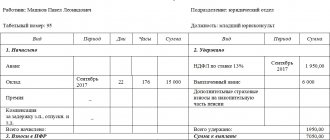Number of vacation days in 2020
The minimum duration of annual paid leave is 28 calendar days (Part 1 of Article 115 of the Labor Code of the Russian Federation).
From the letter of the Ministry of Labor dated September 24, 2019 No. 14-2/OOG-6958, we can conclude that an employee must take 14 days off in a row for the current working year. Let me explain.
The Labor Code of the Russian Federation allows annual paid leave to be divided into parts by agreement of the parties (Part 1, Article 125). In this case, one of the parts must be at least 14 calendar days.
Sometimes an employee urgently needs unscheduled leave - from the next day at his request. In this case, the accounting department usually has difficulty applying and complying with the statutory deadline for payment of vacation pay. In addition, there is conflicting jurisprudence on this issue. ConsultantPlus knows how to properly pay vacation pay in the event of a sudden vacation and avoid administrative liability for failure to meet the payment deadline :
At the personal request of the employee, the employer has the right to postpone the employee’s annual basic paid leave, despite the approved vacation schedule.
In this case, it is necessary to comply with the requirements of Art. 136 of the Labor Code of the Russian Federation, according to which payment for vacation is made no later than three days before its start. If, upon application, the employee is granted leave the next day after submitting the application, and the accountant does not have time to accrue and pay vacation pay within the period established by the Labor Code of the Russian Federation, then... Read the complete decision.
According to the Ministry of Labor, at least 14 calendar days should be part of the annual paid leave for the current working year. If an employee, for example, takes 7 days for the last year and 7 for the current year, the requirement of Part 1 of Art. 125 of the Labor Code of the Russian Federation will not be implemented .
EXAMPLE
The employee has accumulated 7 unused calendar days of vacation over the past working year. He plans to add them to the vacation for the current working year. In this situation, the duration of one part of the vacation in the current year should be at least 21 calendar days (14+7). Then there will be no . That is, the employee must take at least 14 days off in a row for the current working year.
At some enterprises, it is customary to give short-term vacations (1-2 days) due to the large number of unused vacation days. It is important to know that the timing of payment of vacation pay for a one-day vacation has its own characteristics and risks. They are explained in ConsultantPlus:
However, providing employees with leave of a specified duration is associated with certain difficulties and risks for the employer, associated, in particular, with the timing of payment of vacation pay.
Read the entire consultation.
Calculation of vacation pay for summarized accounting of working hours
If the enterprise operates continuously, summarized working time recording is usually established for employees. Then, for each employee, the number of hours worked per month, quarter, half year and year is taken into account.
When accounting for working time in aggregate, vacation pay and compensation for unused vacation are calculated in accordance with Article 139 of the Labor Code of the Russian Federation.
First, determine the average hourly earnings, and then calculate the average earnings to calculate vacation pay.
Formula for calculating average hourly earnings with summarized accounting of working hours
| The amount of accrued payments for hours worked in the billing period, taking into account bonuses, allowances, and incentives | : | Number of hours actually worked in this period | = | Average hourly earnings |
Formula for calculating average earnings with summarized accounting of working hours
| Average hourly earnings | × | For the number of hours according to the schedule in the billing period | = | Average earnings |
How vacation is paid according to the Labor Code of the Russian Federation in 2021
While the employee is on vacation, he retains his place of work (position), as well as his average earnings (Article 114 of the Labor Code of the Russian Federation). Already from this provision of the Code it is clear that vacation payment is made based on the employee’s average earnings.
Calculating vacation in 2021 should begin by determining the calculation period. If a person has been working at his place of work for more than 1 year, then this is 12 calendar months preceding the month the vacation begins (clause 4 of the Regulations, approved by Decree of the Government of the Russian Federation of December 24, 2007 No. 922).
That is, when calculating vacation pay, you need to use the employee’s income received during these 12 months. In this case, a calendar month is the period from the first to the last day of the month inclusive.
EXAMPLE 1
The manager has been working at Parma LLC since February 5, 2021. From June 3, 2021, in accordance with the vacation schedule, he must be granted annual paid leave. This means that his average earnings are determined for the billing period - from June 1, 2021 to May 31, 2021.
EXAMPLE 2
Calculation of vacation pay for a fully worked pay period in 2021
Employee Petrov A.S. in accordance with the vacation schedule, from May 20, 2021, another paid vacation of 14 calendar days should be granted. The billing period is from May 1, 2021 to April 30, 2021. The amount of payments taken into account when calculating average earnings was 516,000 rubles.
Solution
Average daily earnings: 1467.58 rubles. (RUB 516,000 / 12 months / 29.3)
Total amount of vacation pay: 20,546.12 rubles. (RUB 1,467.58 × 14 days)
Vacation pay calculation
Based on Article 139 of the Labor Code of the Russian Federation, the average daily earnings for paying for vacations (and paying compensation for unused vacations) are calculated for the last 12 calendar months. By adding the amounts of wages (and other payments) for each of these months, we get the total amount of earnings, which is subsequently divided by 12 (months) and 29.4 (average monthly number of calendar days). This is how the “price of the day” for vacation payments is determined in the vast majority of cases.









